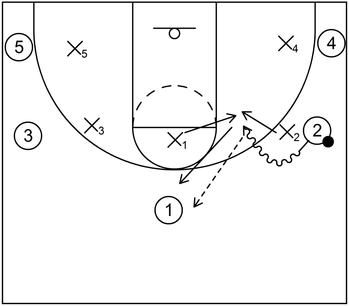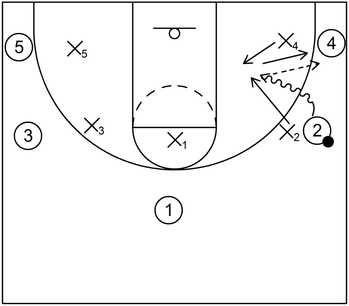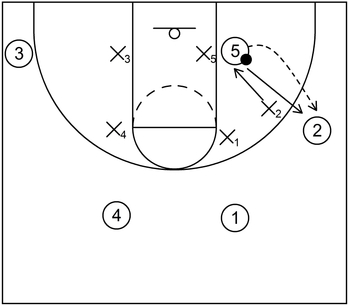What is a stunt in basketball
A stunt, also known as stunt and recover, is a basketball defensive tactic, mainly used within man to man defense, in which an off-ball defender will momentarily step towards an adjacent offensive player with the ball and then return to the specific offensive player that they are currently guarding.
Why is the defensive stunt a potentially effective tactic
The defensive stunt is a potentially effective tactic because it could be primarily implemented to hinder perimeter dribble penetration but it could also disrupt low post offensive execution as well.
Both of those situations could lead to limited scoring opportunities for the offensive team which is beneficial for the defensive team.
Hinder dribble penetration
As an example of dribble penetration hindrance, let’s say an offensive player is in possession of the ball at the top and that same player is being guarded by an on-ball defender.
Furthermore, let’s also say there is an off-ball defender currently covering a second offensive player near the right side wing.
From that point, let’s assume the offensive player with the ball is able to beat the on-ball defender, particularly with some type of dribble move, and that same offensive player is creating dribble penetration into the gap between the top and the right side wing.
To counter this dribble penetration, the adjacent off-ball defender near the right side wing could stunt at the player with the ball before recovering to their assignment, which is the offensive player near the wing.
The stunt tactic will typically influence the offensive player with the ball near the top to either slow down their dribble or pass the ball to the offensive player on the wing.
If the offensive player slows down their dribble and hence, restricts their dribble penetration, then this could give the on-ball defender that was beat enough time to get back in front of the player with the ball.
Conversely, if the offensive player with the ball decides to pass it to the player on the right side wing, then this effectively ends their dribble penetration altogether.
Also, at the same time, the stunting defender will be in a great position to get into the proper defensive stance and play solid on-ball defense against the offensive player on the wing, in current possession of the basketball.
Disrupt low post execution
As an example of low post disruption, let’s say an offensive player has the ball near the right side low post area while being guarded by an on-ball low post defender.
Let’s also say there is an off-ball defender currently covering a second offensive player near the right side wing.
Moreover, let’s assume that the player with the ball is the offensive team’s best low post player and that same player is also the team’s leading scorer.
From that information, the adjacent off-ball defender near the right side wing could disrupt the rhythm and execution of that low post player by stunting at the ball.
As a result, the low post player might be influenced to pass the ball to another teammate, preferably near the perimeter, which is very favorable for the defensive team.
In addition to that, the low post player could simply settle for tougher low post shots.
In other words, the low post player may typically take a hook shot towards the middle of the lane but because of the stunting defender in the vicinity, the low post player might decide to settle for the more difficult baseline fadeaway shot.
What are simple diagram examples of defensive stunting
Example 1

This is an example of a defensive stunt and recover tactic when the ball is at the top. To begin, 1 creates dribble penetration in the gap between the top and the right side wing.
When that happens, X2 can stunt at the ball to restrict the dribble penetration of 1 which also gives X1 an opportunity to get back in front of the ball.
Additionally, if 2 receives the ball from 1, then X2 can quickly recover to become the new on-ball defender.
Example 2

This is an example of a defensive stunt and recover when the ball is on the right side wing. To start, 2 generates middle penetration towards the lane in the gap between the wing and the top.
Afterwards, X1 plays nail defense and could then stunt at the ball to hinder dribble penetration while X2 gets back in front.
Furthermore, if 1 receives the ball from 2, then X1 can recover into the proper defensive stance.
Example 3

This is an example of a defensive stunt when the ball is on the right side wing. To start, 2 produces baseline penetration towards the basket in the gap between the wing and the corner.
Following that, X4 can stunt and recover to slow down the dribble action of 2 while giving X2 enough time to get back in front of the ball.
Moreover, if 4 receives the ball from 2, then X4 is ready to defend with proper on-ball defense.
Example 4

This is an example of a defensive stunt when the ball is in the low post near the right side post block. To begin, X2 stunts at the ball which influences 5 to pass it back out to the right side wing.
From there, as 2 receives the ball, X2 is able to recover into solid on-ball defense.